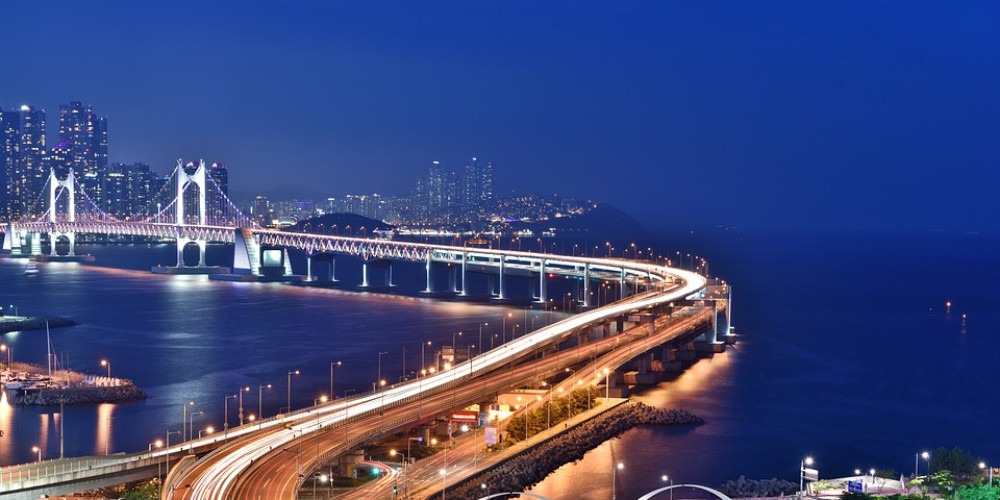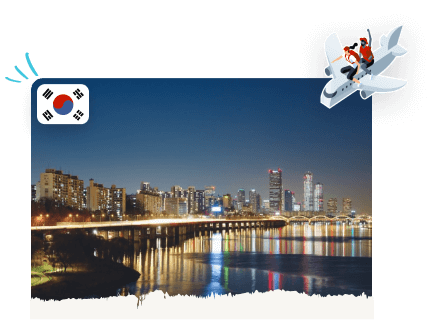
The capital of Asian cinema, the second largest city of an incredible country called South Korea. Busan is a city that can only be fully understood by the heart. The colorful beaches and succulent seafood. Crowded markets, painted village streets and wonderful cultural attractions. In a city that never sleeps, you will not be bored. "Which is better Seoul or Busan?", " Busan or Seoul?", " how to get to Busan?". If there are a lot of questions, but no answers, 10 reasons to travel to Busan – a real lifesaver! Leave your doubts behind. The train to Busan is waiting for you!
1. Free hiking

When asking the question "Which is better Seoul or Busan?", give preference to the seaside city, if hiking is both breads for you and entertainment in travel. A fantastic variety of spacious paths and narrow paths of any level of difficulty will open up to you as soon as the Busan train arrives at the final station. From the slopes of Mount Jangsan (Jangsan Mountain, 장산), for example, the ocean views are unimaginably beautiful. On the other side, there are fields of lush grasses that shimmer to match the silver necklace in the sun. If you like to walk alone, Geumnyeongsan Mountain (경산) is a great choice. Easy, quiet and deserted – what you need for a pleasant morning workout. Some tracks are more likely to resemble complete off-road than intended for walking paths. If your physical fitness allows, get to know them better. So you will most likely cross paths with a couple of local residents – they love hiking in a bumpy way. For a bit of variety in your hiking, head to the hamlet of Gamcheon Cultural Village, the epitome of chaos and beauty fused together in the maritime capital of South Korea. Located at the foot of the mountain, the abode of slums in the past, today it is full of houses built as if from Lego pastel shades. The latter appeared here in 2009, and the alleys formed between them became guides to the steep slopes and narrow alleys for tourists. Homely art galleries, the eye-catching architecture of winding streets and quirkily original cafes-are imbued with the spirit of authentic Asia.
2. Cheap food is everywhere

Despite the difficulties of keeping up with the competition of the immaculate cleanliness of supermarkets and the pretentiousness of department stores, the traditional culture of market trading in Busan is still thriving. Once on the alley with the eloquent name "Let's have a snack! " (Changseon-dong's Meokja Golmok, 먹자골목), it is very difficult to resist the gastronomic temptations. And why?! Uncomplicated and more than affordable Korean cuisine from local chefs-keepers of the culinary secrets of the genus. Sitting on a plastic stool (just like that!) under the open sky, do not fail to try a little of everything: chunmu kimbap (steamed buns with rice filling), pibimpab (boiled rice with vegetables and thinly sliced beef with hot kochhujan sauce) or a pair of pajen pancakes with a filling chosen at the discretion of the chef. For a sweet tooth near the city of Busan or Seoul (as you like!) there is a separate surprise – delicious pancakes with brown sugar, honey, seeds and peanuts (ssiat hotteok). Searching for routes on the search query "how to get to Busan" is only a waste of time, if you do not try the hearty rice and meat soup dwaeji gukbap on arrival. And you won't be able to stop. A flavorful broth, which cooks manage to achieve a milky consistency by simmering a pork bone in boiling water for several hours. Pork shank, soy sauce, homemade miso and sesame oil for a captivating flavor. Despite all the efforts invested in the preparation of this culinary masterpiece of traditional Korean cuisine, the price is very affordable!
3. Of course they are seafood

Do not say that you had to deal with seafood until you had a "dancing" octopus on a plate in front of you. And after all, at the final point of the route "how to get to Busan" only so! Fresh, delicious seafood prepared in all the ways known to chefs – the sea capital of Asia and the world is waiting for you. The bustling Jagalchi Market (부산 자갈치시장) is a real fishy place for fans of "born of the ocean". And the coastal restaurants here are a great reason to get the train to Busan right now. The fragrant, juicy, alluring clams, fried on a slow open fire, have every chance to win the palm in your rating of Korean delicacies. Generously pour the babies with melted butter and garlic, add a drop of soy sauce and do not restrain yourself – how delicious it is!
4. Sunny beaches and seascapes

The maritime capital of South Korea is known not only for its strategically important location called "Busan Port", but also for its hundreds of kilometers of picturesque coastline. Although the local Busan beaches do not boast first-class resorts or dozens of first-line hotels, the intriguing breeze of city bustle and beach tranquility can surprise even the most pampered tourist traveler. In summer, Haeundae Beach (해운대해수욕장) is especially popular, filled with families, couples in love and noisy companies, whose main goal is to soak up the sun. Be sure to visit the annual sand festival, which features hundreds of impressive sand sculptures by creative artists from around the world. If choosing Busan or Seoul - which is better, you are primarily looking for peace and quiet, add Songjeong Beach (송정해수욕장) to your tourist route. Unique and far from the beaten track, it is famous for its incredible sunrises and idyllic, bone-piercing silence. Rent a small motorcycle to explore the local beauty with the breeze, watching the changing horizon from dawn to sunset from the corner of your eye.
5. The magical charm of Buddhist temples

The territory of Busan is literally strewn with Buddhist monasteries – colourful and ascetic. Many religious buildings here seem to have grown out of nowhere – they are on the peaks, and under them, and inside the rocky mountains, and at their feet. Although the pagodas are now awarded the best views of Busan (it does not matter at all!), in the past they were awarded the role of witnesses of wars, civil strife, bloodshed and all that the Korean people would prefer to forget. Today, any of the monasteries will amaze you with the brightness of the painted ornaments, the grandeur of the golden Buddha at the head and the atmosphere of spiritual mystery that envelops you from head to toe. Unlike most temples perched on the tops of mountains and their slopes, Haedong Yonggungsa (해동 용궁사) is literally perched on the coast of the East Korean Sea. It got its second name – the Water Monastery-due to the stunning landscapes surrounding it, the border of which is the horizon of the water surface. Special attention should be paid to the three-stage pagoda, on the edges of the curves of which four lions sit solemnly-joy, anger, sadness and happiness.
6. The luxury of cinema

Sometimes referred to as Asian Ganges, Busan is the birthplace and center of South Korean (and not only!) cinema. The annual Busan International Film Festival (PMC) is held in October and has become known as one of the most significant industry events within the whole of Eurasia! World-famous actors, directors, screenwriters and everyone involved in the creation of films come here from all over the world. You can even get to know them! To do this, you do not need to act as an extra – regular walks in the fresh air increase your chances of crossing with someone from the celebrity. Half a kilometre from the PMK Square is the local walk of fame, along which busts of movie stars flaunt. And right under your feet – the prints of the hands and fingers of the audience's favorite actors and other significant participants in the filming process.
7. The frenzy of baseball games

When planning a trip to the port of Busan and visiting other iconic places in the city, you are unlikely to add a baseball match to your tourist to-do list. And make the biggest mistake possible! Memories of attending a baseball game to support the local heroes of the Lotte Giants are a priceless treasure for your imperishable collection. Pack a solid snack and be ready to spend the whole day drinking beer (or better yet, Korean soju!), sitting shoulder to shoulder with the fans chanting encouraging slogans. Take part in dances, flash mobs and chants – become a part of the crowd inspired by the belief in victory. You will have nothing to regret – the ticket price is too democratic!
8. Crazy shopping and relaxation in the best spas in Asia

When the temperature rises to an unforgivably high level and the coveted trip to the port of Busan seems like a stupid idea, arrange a shopping therapy. Even if you are a proponent of the concept of reasonable consumption and do not like to just go shopping, take a couple of hours of your time to visit the largest shopping center in the world (Shinsegae Centum City, 신세계 센텀시티). What if you want another couple of degrees hotter? 450 hot springs – more than any metropolis in the country of South Korea can offer. There is no better place to get acquainted with the Jjimjilbang bath culture and to absorb its features as much as possible on the peninsula. Scrubs, relaxing saunas and rejuvenating treatments-you won't be able to stop! In the largest spa complex in the city - Spa Land - several dozen hot springs will heal your body and soul.
9. Ease of travel and the hospitality of the locals

Compared to Seoul and other major cities in South Korea, Busan has a high population density of the elderly. In public transport, you can start a friendly conversation with a nice old man, he will give you a candy and wish you a good day. Although there are rumors about the rudeness and inhospitality of the locals, in fact, they-born in Busan-are happy to come to the aid of a stranger. Because of this, the city is more like a close-knit community, rather than a metropolis. Chat with Korean people, where possible, from traditional markets in the first place. Knowledge of English, by the way, will help you with this! Even in Busan, you can sing serenades. Simple and budget-friendly - this is how you can briefly describe the road and underground traffic of a seaside city. The metro here works like clockwork, in buses you do not have to fight for a place on the last step. Taxi rides, however, can add an adrenaline rush to your travel routine – drivers' driving speed can sometimes be staggering. For that, you will definitely feel like a member of the Formula 1 crew-arriving at your destination on time and without damage.
10. Gorgeous Busan weather

You've probably heard about the unique climate in Korea. Clearly distinguished from each other by the four seasons, a favourable temperature and many other "Goodies". No matter what anyone says, the best weather conditions are in Busan (and not in Seoul!). We will not take into account the cold snowy winters, which, however, will appeal to fans of coolness. Temperatures in summer are much lower here than in other cities in South Korea – good news for haters of excessive heat. Moreover, you will be able to breathe deeply in Busan – the humidity is quite low, but the air is still not dry. What about autumn and spring? It's perfect!


